Our next day was primarily a travel day. We journeyed from Talsi to our next base in Karli, within the Gauja National Park.
Foregoing the A road highway back to Riga, we followed the P128 through the countryside for the coast. Much of the way was forested along both sides of the roadway, a view familiar to us from our home in western Washington. We reached the coast south of the town of Engure. There we found that the road still ran through a forest of evergreens, about a quarter mile inland from the shore, with glimpses of the water. Not wanting to miss the ocean entirely, we stopped at one of the many marked trails running through the woods from road to shore, and took a brief walk on the beach. It was a lovely, vast expanse of sand curving off in both directions, deserted but for one other couple visible a long way off. Ilga stopped for a quick dip in the very warm water, but the many mosquitoes living in the woods discouraged us from stopping for long.
Continuing on, we turned off the main road to cruise through Jurmala, Latvia’s major seaside resort. Its proximity to Riga makes it easily accessible for the population, but in recent years it has become a high-priced area, attracting the very wealthy from Russia, Kazakhstan, and elsewhere in the former Soviet Union. These newcomers build expensive houses on and near the beach, a modern version of the classic beach resorts of yore. We passed through on some of the main strips, but were not tempted to get out and look around.
We took the highway to swing around the core of Riga, and found our way to the Bivdabasmuzejs, the Ethnographic Open-Air Museum of Latvia. This is a large forested park with numerous relocated and reconstructed buildings from the various regions of Latvia, illustrating the different building styles and lifestyles from around the country. We love visiting this sort of museum wherever we find them (Osaka, Japan has a particularly good one, too), and this was an excellent example of the type. The vast museum (215 acres) was started when a barn was relocated to the grounds in 1928. The museum lost much during World War II and was actively discouraged during Soviet times. Since independence in 1991, it has become an active cultural center with 118 buildings (peasant homes, taverns, windmills, farmsteads, fisherman homes, various styles of bath houses (what we know as saunas) and many artifacts. A building was being re-constructed during our visit there, down near Juglas lake shore.
Ilga was particularly excited to talk to the woman weaving on a traditional loom in a weaver’s cottage from the Vidzeme region, and to see the spinning wheel maker’s homestead, also from Vidzeme. As we were leaving an engagement party with traditional costumes and musicians and dances was in process at the main hall. Alas, we were very absorbed in the museum and didn’t get any pictures, but you can find them readily on the internet: http://www.google.com/search?q=Brivdabas+muzejs&source=lnms&tbm=isch&sa=X&ved=0ahUKEwiP0qbY3o7UAhVDxoMKHVbwC9IQ_AUICygC&biw=1207&bih=744 and click on images. There are a fair number of Latvian mittens displayed in the photos as well!!!
Time was running low, so we carried on to our base for the next three nights, the Karlamuiza guest house. This is situated in a 19th century building on the grounds of an old country manor, set in the midst of the Gauja National Park. The building was once used as a school for gardeners and nurserymen. Now it is a comfortable small hotel, adjacent to some of the national park trails.
On our way out of Liepāja the next day, we drove through the remains of the big Soviet naval base on the north side of town. During the Cold War, the presence of this base made Liepāja a restricted town, with limited entry and exit even for residents. The city was in fact removed from maps, as a way to limit information about it. One of the more bizarre tourist activities on offer in Liepāja is the chance to spend a night in a cell at the base’s jail, as if you were a prisoner of the Soviets. You can even have guards come by and yell at you to wake up every hour or so. We passed on that opportunity!
On the outskirts of the base complex, we passed the cemetery associated with it. We were struck by the many flower arrangements left everywhere, a profusion of color brightening what might otherwise be a somber place. We saw the same sort of devotion to graves at other cemeteries we passed throughout Latvia. In fact, we found a gardening book at one of the many bookstores we visited in Latvia which was devoted to cemetery gardens.
Our first destination of the day was the town of Grobiņa, just inland from Liepāja. Grobiņa had been an important settlement in the eastern Baltic for the Vikings. It was accessible by sea for them, but now the river has silted and is no longer navigable.

View of river at Grobiņa from pilskalns
There are a number of Viking-related archaeological sites in the immediate area, enough, in fact, that it has been nominated as a UNESCO World Heritage Site. We visited the pilskalns, where we saw active excavations. From the hill, there was a view over the waterway and a small rope pulled ferry (raft).

River ferry at Grobiņa
The adjacent ruins of the Livonian Order castle were quite picturesque.
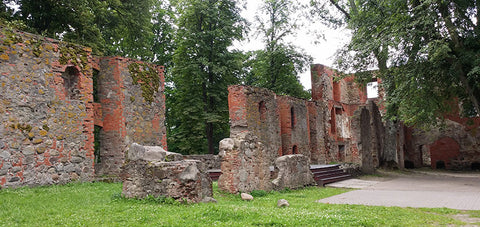

Castle ruins at Grobiņa
Ilga chatted with an elderly lady working in the nearby community garden, flush with flowers and vegetables. She told us about her son who lived in America, and how he kept urging her to come out to live with him. It was another chance to prove to Ilga that she still had proficiency in her first language.
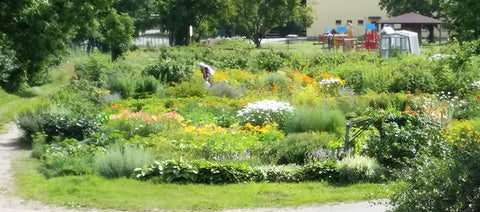
Community garden at Grobiņa
Moving, on, we passed through Aizpute, where we hoped to visit a weaving studio listed in the tourist information, but it was Sunday, and the entire town was shut tight---not much happening in a Latvian provincial town on a Sunday. We did stop to look at the inevitable castle ruin overlooking the river. Although Aizpute is far inland, this river too had once been navigable by boats running in from the sea.
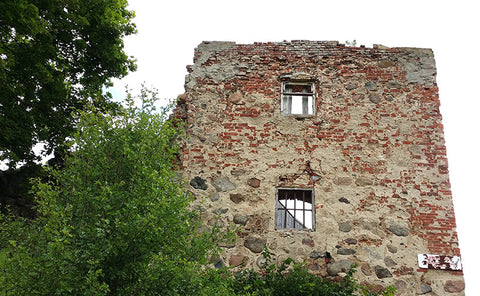
Castle ruins at Aizpute
Our main destination of the day was Kuldīga. This is considered one of the most beautiful, best preserved medieval towns in Latvia, with many buildings from the 13th to 18th centuries still standing.
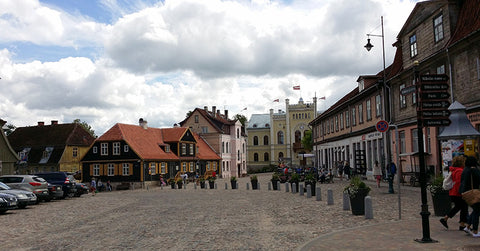
Kuldīga main square
It was first mentioned historically in 1242, when the Livonian knights requested permission to build a town on the river. The foundation stones of St. Catherine’s church were laid in 1252. We strolled around the castle hill. Alas, the castle itself was demolished and the stones used for other buildings long ago. The walkway through a park and gardens took us to the famous Venta waterfall. This lays claim to the title of Europe’s widest waterfall, although the river’s gentle flow and the falls height of only about 6 feet makes it unintimidating.
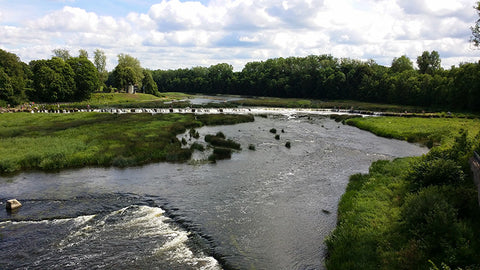
Waterfall at Kuldīga
There was a beautiful view of the waterfall from the picturesque bridge.

Bridge at Kuldīga
We strolled up Liepāja Street, the main pedestrian promenade and shopping street in the old town, enjoying the street scenes and the old buildings.
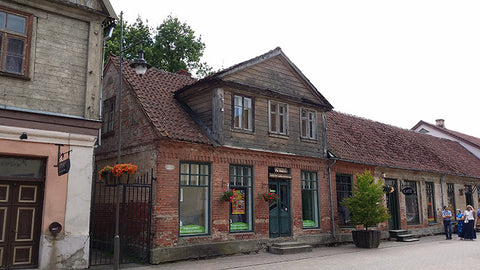
Street scene in Kuldīga
Doubling back on a parallel street, we encountered a lovely Orthodox church.
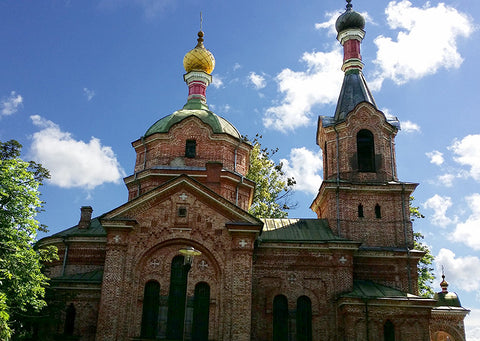
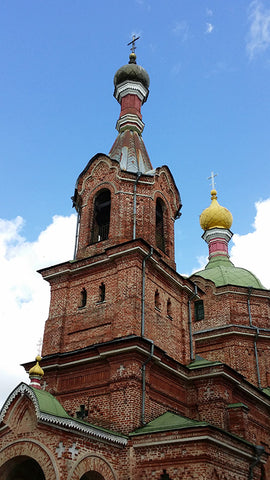
Orthodox church in Kuldīga
Just to the side, we found a sculpture garden filled with humorous wooden sculptures.

Garden of wooden sculptures
After sitting and feeding some pigeons, a little further on, we stumbled upon a Trojan Cat art piece place in front of the music academy, created by the artist Aigars Bikše.

A Trojan cat
Our final destination for the day was Talsi, where we were to spend the night at a guest house with the very un-Latvian name of Martinelli. Legend has it that a soldier by that name from Napoleon’s army stayed behind after the army’s retreat and made his home in the town.

Talsi
The lake in Talsi was, for a time, named for him. Our gracious hosts at the Martinelli Guest House operate a very fine traditional Latvian food restaurant (even better than Ilga’s Grandmother’s food!!! And that’s saying something) and a lovely small guest house, where we thoroughly enjoyed our stay. After dinner, Mike took a walk over the pilskalns and around the lake. In the morning, after one of the best breakfasts of our trip, our host took Ilga to visit a local weaving studio. This is part of an artist’s group that was established within the Tasli Regional Museum. The artists include painters, sculptures, photographers, textile and jewelry artists.
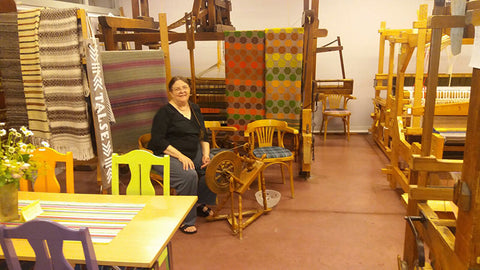
Fiber studio in Talsi

Big loom in the fiber studio
We awakened the next morning to find that Liepāja was setting up for its annual Sea Days festival on the promenade along the waterway. Our hotel (called the Promenade Hotel, and built in an old grain warehouse) was located right there on the Trade Channel. The Trade Channel was excavated when the previous harbor silted up. Today the main port is elsewhere, but the channel is used by pleasure boats, smaller fishing boats, and the Latvian Navy. For Sea Days, the promenade was filled with market stalls selling “Saturday Market” sorts of goods. Local smoked fish were particularly in evidence, as well as home-baked goods, homemade cheeses, honey, and many craft items and food and beer stalls for lunch. Mike bought a new belt, embossed with symbols of the ancient Latvian gods, hopefully thereby gaining their protection. Ilga was thrilled to find a window sticker with her name on it. She had always pined for something with “Ilga” on it….not a likely occurrence in the USA!
After strolling the market, we went into the center of the old town. The architecture of central Liepāja is quite striking; a wide diversity of building styles all jumbled together. Antique wooden houses stand next to grand early 20th century mansions next to Soviet-era concrete boxes. During the 19th century, the city had been a seaside resort town with “wood lace” ornamented grand homes, and some of the remains of that time are still in evidence. Unfortunately, damage during the two world wars opened up vacancies that have been filled in with less graceful structures. The mix of styles gave us a sense of discovery as we turned each new corner. We were also amazed to find an ancient building right in the middle of town. This building illustrated an interesting old metal reinforcement to the dovetailed building construction.
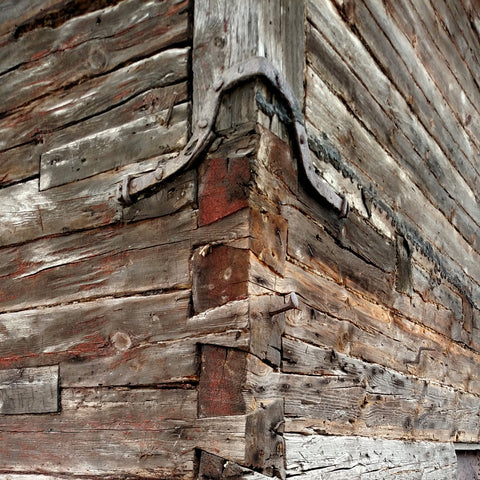
Unique metal bracing on old wooden building
We strolled through Rose Square, the town's central plaza, and watched the buskers. The city, as nearly everyplace we went in the Baltics, was filled with flowers, including a topiary butterfly in front of the university.

Street flowers in the Liepāja town center
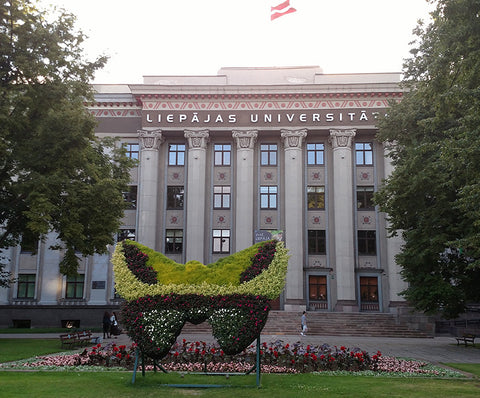
Topiary butterfly in front of Liepāja University
After a stop at the tourist information office, we wandered down the pedestrian-only shopping street, spotting among other things in the shop windows a tee shirt celebrating Chikago. We were headed to St. Anne's Church, the major Lutheran church in Liepaja, and the site of Ilga's mother's baptism. The helpful attendant gave us a little history of the church. The church has a grand 16th century wooden altarpiece, unfortunately in need of restoration and protection for termites for which, alas, there isn’t enough money.
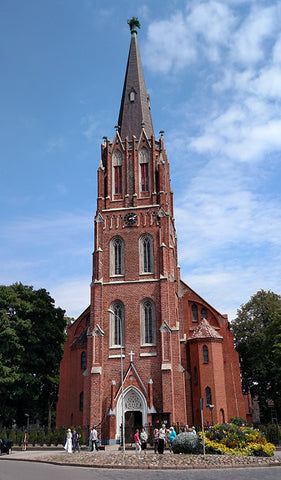
St. Anne's Church
We ran across the Liepāja gymnasium and wondered if, perhaps, Ilga’s mother had gone there.
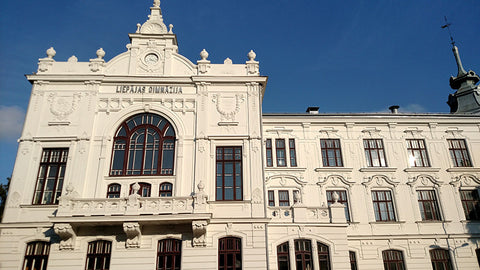
The grand gymnasium building in Liepāja
A few blocks away was our next stop. Peter's Market, an Art Nouveau building erected in 1910, is considered one of the most beautiful market buildings in Europe. Inside were vendors selling meat, cheese, honey and other produce, while the fruit and vegetable vendors were in the outdoor stalls. We sampled unfamiliar varieties of cherries, and examined the many types of potatoes on offer. Inside, we purchased some pirogi (bacon and onion stuffed rolls) and a jar of honey. Seeing our purchases, one of the market ladies laughed and said that we had “the essence of Latvia” in our hands.
Liepāja is particularly proud of its efforts to make the city accessible to the disabled. On both the waterfront promenade and in the downtown, we saw lovely three-dimensional bronze maps, accompanied by Braille keys, to help the blind navigate the area.

3-dimensional town center map with Braille captions, for the blind
We returned to the hotel, and were fortunate to find a parking spot right in front of the hotel. A feat, considering all the confusion of the festival. We had missed the Viking boat races, but the children's games were still going. Ilga particularly liked the plunger races -- kids lay down on boards fitted with skateboard wheels, and propelled themselves along by “walking” the toilet plungers like oars through a winding course. We were also amused by the seller of spiral cut potatoes. He placed a whole potato on a skewer, fitted the skewer to a hand held drill, then held it against a homemade jig that made a continuous spiral as the drill spun. He then dropped the skewer into hot oil, and in a few seconds the whole potato had been rendered into a single spiral potato chip.
The craft market was winding down by this time, but the festivities were not over. Mike took the offered tour of the Latvian Navy's minesweepers, docked on the channel for the festival. A couple of outdoor stages featured a variety of acts throughout the day. In the market stalls on the perimeter of this venue, we found a fellow Etsy seller and her booth. Sandra of SandrasMagic hand-knits shawls and sweaters, using both traditional Latvian designs and techniques, as well as more modern approaches. Ilga found a shawl she liked, adding to her collection of authentic Baltic knitwear.
We walked through the town's new Great Amber concert hall across the street from the Promenade. This striking building, clad in amber colored glass, is one of Latvia's three regional concert halls, each dedicated to supporting the unique cultures of Latvia's different sections.
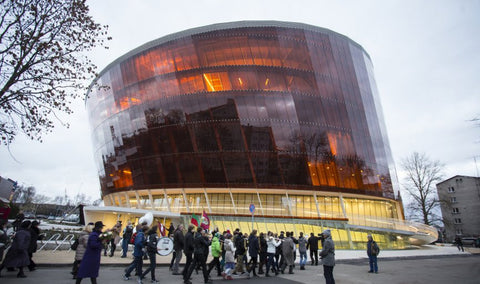
The Great Amber Concert Hall. Photo by Aigars Prūsis.
The festival continued into the night with more music. Liepāja is known as the center of Latvian rock music, so local bands were featured well into the night. But, after dinner in the hotel’s beautiful restaurant with amazingly HUGE rose murals, we retired to our room, having already had a really full day of exploration.
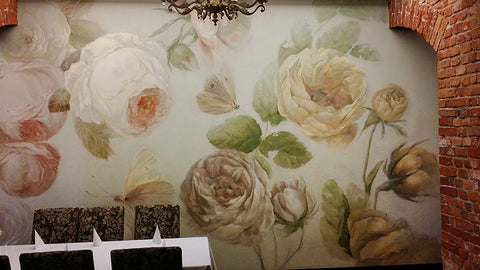
Part of the mural in the Promenade Hotel restaurant

Detail of the restaurant mural
We collected our rental car in the morning (a black Volkswagen Passat, same as the one we drove from Tallinn. This particular one had previously belonged to the Latvian Department of Education) and headed out of the city. On the outskirts of Riga, our first stop was a grocery store. We always do “supermarket tourism” wherever we go. Ilga oohed and aahed over the various items she recognized from her childhood. Lunch supplies in hand, we set out for Jelgava.
Ilga’s mother had lived in Jelgava as a girl, so it held special interest for her. It is the fourth largest city in the country (although its population is only about 60,000). It was nearly totally destroyed in the war, so most of the buildings date from the Soviet era. We spent most of our time in the rebuilt steeple of the ruined Trinity Church. It was all that remained of the original massive church.
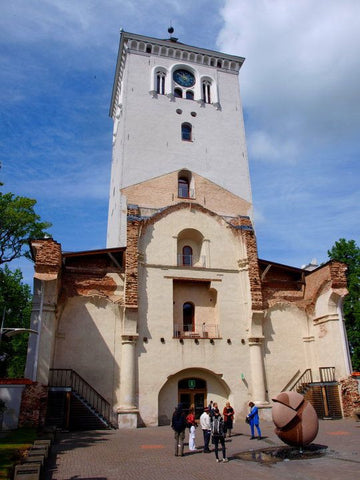
The reconstructed steeple of Trinity Church. Photo from http://podroze.onet.pl
This housed a fine small museum detailing the history of the area and the local folk costumes and a whole floor dedicated to fiber arts!

Plaques in the fiber arts section of the museum
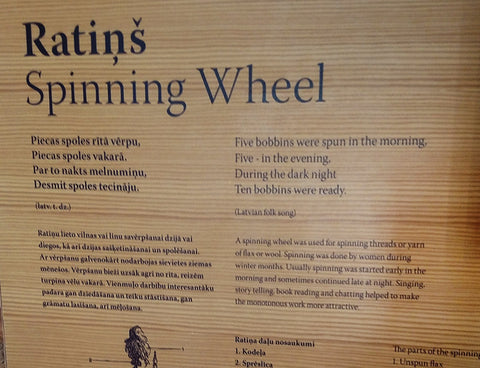
Plaque in the fiber arts section of the museum
The plaque discussing spinning wheels quotes an old folk song - Five bobbins in the morning and five in the evening... - I have really got to get my spinning act together!!! The top of the steeple featured a glass-walled look-out room, with expansive views of the surrounding country, including the park around the river, and the restored palace of the dukes of Courland, now an agricultural college.
Mike had seen references to local Iron Age hill forts in the museum displays, and wanted to ask the staff in the tourist information office at the base of the steeple about any nearby that could be visited. Unfortunately, the English-speaking staffer had left, so Ilga struggled to explain by trying various direct translations of “fort place” or “defensive place.” Flustered, she couldn’t remember the word for hill or mountain. Little progress was made until Mike recognized the name of one on the map, Tervete. That instantly illuminated what we were asking about. The staff directed us down to Tervete, and we learned the word for hill fort: pilskalns, literally “castle hill”.
After a brief lunch by the river in Jelgava, entertained by begging seagulls, we set off for Tervete. The drive took us through the farmland of Zemgale, considered the bread basket of Latvia. The countryside lived up to its name as extensive fields of grain lined the road in all directions. The village of Tervete itself was more of a speck on the map than anything else, but on the road out of town we found the pilskalns, as well as a forest park, and a partial reconstruction of an Iron Age stockade. We took a walk to an idyllic house and garden in the woods, the preserved home of Anna Brigadere (1861-1933), a beloved Latvian children’s author.
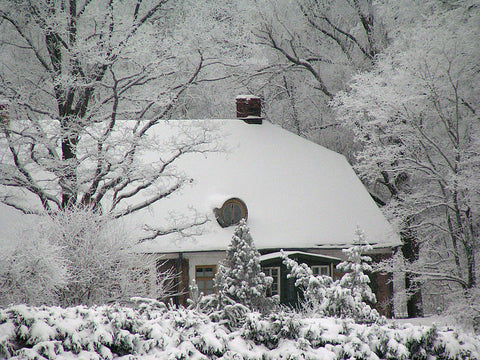
Anna Brigadere's house, in winter. Photo by Igors Jefimovs
Unfortunately, it was raining hard, so we didn’t spend as much time as Mike would have liked. This was really the only day that the rain interfered with our plans in Latvia
Setting out again, we headed for the town of Dobele. The center of town had a nice castle ruin, so we stopped long enough for Mike to take a quick walk around it under threatening skies, while Ilga knitted in the car. A wedding party was trying to dodge the rain as they posed for photos in the castle grounds. Our tourist information told us that Dobele held the Latvian State Institute of Fruit Growing, an extensive garden of fruit trees, based on the work of a renowned local plant breeder, Pēteris Upītis. Unfortunately, the garden was already closed by the time we arrived, as indicated by the Latvia version of a Beware of Dog sign on the gate: Nikns Suns!, or literally, “Angry Dog!”. We try to collect local versions of "Beware of Dog" signs when we travel, especially if they depict German Shepherds, but we unfortunately did not find one of these for sale.

Beware of Dog sign at the Dobele Fruit Growing Institute. The sign translates literally as "Angry Dog!"
The small museum on site was also closed, but some staff was still there. They invited us in to come in and look around. It held a room of artifacts from Mr. Upītis, and a display of botanical paintings by local artists, which had been hung in preparation for the big civic festival planned for the next day. It was a lovely visit and another example of the hospitality of the people we encountered.
Time was running on, so we pushed on to Liepāja, our destination for the night, on the A road (highway), avoiding the temptation of further stops. It was a Friday night, so there was a certain amount of traffic, we assumed people from Riga going to the seaside for the weekend. We let them all pass us so that we could drive at a more leisurely pace and enjoy the countryside.
The next day was our only full day in Riga. The city was beautiful, but we longed to see more of the countryside. We intended to stroll around the old town, but as we often do, we assigned ourselves a mission, to give direction to our wanderings. One of my favorite ways to explore is to visit all the yarn stores we can manage. This gave us a zigzag route that provided a good sampling of the sights of the old town. We consulted the internet to build a list of places to visit, and in particular found this blog helpful: http://www.kikamoracrafts.com/blog/read_130013/yarn-shops-in-riga-list-of-my-favorites.html. It is written by a local knitter named Laura, who Mike later met when he visited the shop she worked in on our last day in Latvia. (He bought a nice skein of local yarn for me there!)
The old town of Riga is a mix of buildings of many ages, from the founding of the German city in the 13th century into the present day. There are a number of massive churches, expansive squares, old merchant houses, grand Art Nouveau mansions and hotels, and on and on. Most are now in good repair, and the city offers, at least on a summer’s day, a bright, welcoming aspect. It is popular with tourists, but unlike Tallinn, didn’t feel overwhelmed by them.
Two of the yarn shops we visited stood out. The first is the famous Hobbywool, already well known to fans of Latvian knitting. We fingered lots of Latvian made wool, and eyed their “Knit Like A Latvian” kits. The shop is in a little alley which is VERY “yarn bombed!” I especially liked their mascot, a carousel horse fully covered in a knitted skin.
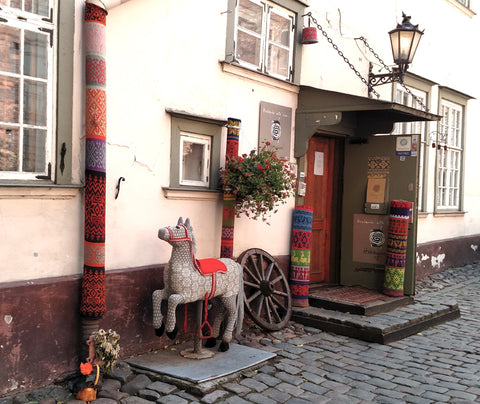
Entrance to Hobbywool
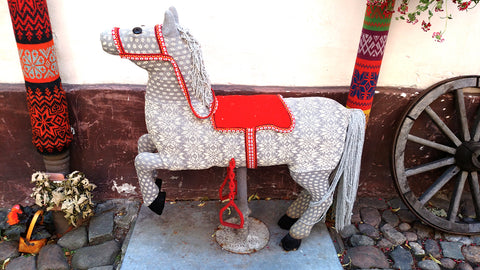
The yarn-bombed horse at the Hobbywool door
The shop that really made my heart go a-flutter was called Dzijas, which just means “yarn” in Latvian. It lies a little out of the old town, down a crooked little staircase in a basement; very obscure and a little hard to find. Once there, though, we found a small room crammed floor to ceiling with yarn of all kinds of colors, much of it unlabeled, with an opaque organization. The proprietress, however, knew every skein she had, and where to find it. It is one of those shops with just a single, narrow path through all the merchandise, and barely room for more than a couple of customers at a time. I was in heaven…and though tempted, only bought a small amount of lovely mohair silk for a future lace shawl. The absolutely gorgeous fine pearl cotton from Russia with an amazing array of colors and very reasonable price was hard to leave behind. It would have been perfect for weaving, but, alas, cotton is very heavy and we didn’t have much leeway in terms of airport rules.
After escaping from Dzijas without too much damage to the pocketbook, we crossed back over the old moat, and through the park that traces the old line of fortifications. We lingered in front of the beautiful Opera House, with its formal garden setting. Alas, nothing was playing there during our visit. We then climbed Bastion Hill for the view, and wandered back to our hotel for an afternoon break.
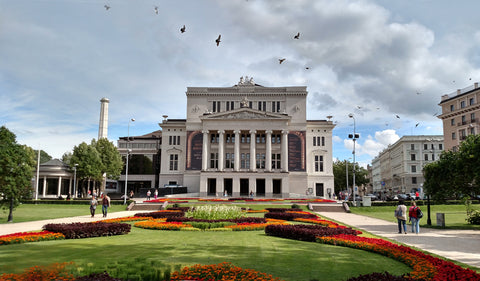
Riga Opera House

View of the Independence Monument from Bastion Hill
For dinner that night we went just a few doors up from our hotel to the 1221 Restaurant, considered one of the best in Riga. The name comes from the date of the building housing the restaurant, one of the oldest surviving in the old town. It was apparently built for the founder of the brotherhood of beaver hunters. We had a fine meal of modern interpretations of traditional Latvian cuisine, and watched with pity as the servers negotiated four flights of stairs to carry plates up to the rooftop terrace (we were on the second level). One has to be fit to work in this restaurant! Among the menu items that we sampled there were duck confit with black current-chocolate sauce with fresh currents and asparagus and a wonderful and quite unique pumpkin seed ice cream with chestnut orange sauce and balsamic cherries. This is the only place we’ve ever seen smoked beaver meat on the menu, although we didn’t choose to sample it.
After dinner, we took a stroll through another corner of old town, and came upon a building in the process of demolition. The façade was braced and left standing (which I would guess is required for historical preservation) while the interior was gutted. This was on a small street where, unlike most of the rest of the old town, the buildings were not so well maintained. We guessed they were all due to be modernized soon.
As we made our way back to our hotel, we could see that the neighborhood bars and restaurants were filling up with young people, most of them watching the EuroCup soccer match. The nightlife was coming alive, just like it might in Seattle’s oldest neighborhood, Pioneer Square, and countless other historic quarters in modern cities.
The road south from Pärnu was less scenic than we hoped, since it is inland from the seashore, and screened on both sides by trees. This is a highway, the main route between Tallinn and Riga, so it was busier and faster moving than most of the roads we had been on. Soon we came to the border with Latvia, which had an inspection station for commercial trucks, but which we just drove through.
Our first stop in Latvia was at the Randu Pļava, or randu meadows. This is a nature reserve protecting an area of seaside meadows, home to many rare plants, as well as more species of birds than anywhere else in Latvia. A short walk through the woods took us to the meadows, covered in tall grass and wildflowers. Boggy spots kept us from approaching the beach itself, and the boardwalk out to the birdwatching tower was unfortunately deteriorated and impassable, but it was a good introduction to a bit of unique Latvian nature. Ilga had a less welcome nature experience here, with her first encounter with Latvian mosquitos.
Continuing south, we felt the urge to get off the busy coast road, so we turned up the P11 towards Limbaži. (The P roads in Latvia are secondary, but paved roads, a step down from the A roads, which are major highways. Freeways as we know them in the USA don’t really exist in Latvia. We always looked for routes on the P roads when we could, to enjoy the quieter pace. Roads out in the countryside that don’t have an A or P designation are often unpaved). We picked Limbaži as a destination because we had read of a felt museum there. We found our way to the local tourist office there for more information.
The Limbaži tourist information office was our first encounter with this very nice bit of tourist infrastructure in Latvia. Every town of size has one of these offices, and they are amply stocked with brochures and maps of all kinds, covering all sorts of interests, generally in at least three languages (Latvian, Russian and English), and often more. In most places at least some of the staff was conversant in English as well as other languages. Limbaži was not one of them, however, so Ilga had to make her first effort to remember her childhood language.
Beyond the language barrier, the staff had no idea what the felt museum might be. Eventually we all came to realize that the internet listing was referring to a large felt factory that had operated in the town for nearly 100 years. One of the old factory buildings was now a community center, and had a small display about the history of the factory complex. The tourist office staff pointed us in the direction of the community center, and called down to let them know these crazy American tourists were coming.
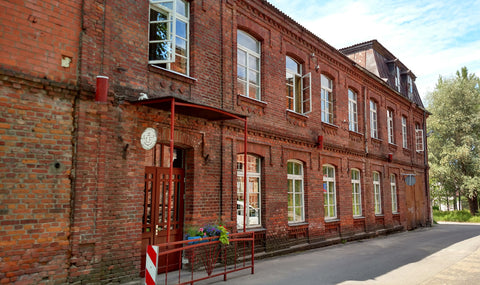
The Limbaži felt factory, now a community center
The director of the center was a very pleasant middle-aged woman, whose English more or less matched Ilga’s Latvian. She explained the history of the building to us. It had at one point been a very large operation, making felt for the hat trade, and making hats as well, but it had closed down 30 years ago. The community center was an effort to repurpose at least one building. It now served kids and adult, with classes ranging from knitting to yoga. Alas, if the director had known we were coming, she would have arranged for the viewing of a film about the factory. Other disused factory buildings, all of red brick, sat scattered around the area, reminding us of other decaying old mill towns we have seen both domestic and foreign.
The director mentioned that there was a woolen mill with an attached store in town, and directed us further down the street to the small shop. Ilga chatted with the shopkeeper, and asked if it was possible to see some of the mill. Sure, why not? The manager himself came out, and gave us a tour of the full operation, from blending the wool through spinning and dyeing to weaving, some of it on truly antique machinery. Alas, since we left our car up the hill and were herded from one place to another (all quickly before closing time), we didn’t have a camera with us.
The first step in the process is mixing the native, somewhat coarse, domestic Latvian sheep’s wool with a small percentage of very short fine wool. (Most current Latvian sheep are a black-faced, long-tailed, polled breed which originated from the crossing of Shropshire sheep (72%) and Oxfordshire sheep (28%) during the 1930’s). This blending (including wool for the grey yarns favored for woolen socks) is done by hand. This is then further blended on a giant drum with very long, coarse teeth. It is measured for the next stage (a run of large six foot drum carders) by a very simple weight calibrated bin which, when full, dropped the wool onto the conveyor. The wool went through three sets of 6 foot drums, being thinned into finer roving between each drum. The end result was a tiny diameter pin roving (about 1/8th of an inch at most). Wrapped onto large 4 foot spools about a foot thick, these were taken to the spinnerets where the wool was spun onto large half meter bobbins. These were then taken to the plying machines. The mill produces 1, 2, and 3 ply yarns. The yarn is then washed and dyed with Swiss ecologically safe dyes, and finished in a steam chamber.
There are also several weaving rooms in the building. The large “commercial” looms were for Limbazu Tine’s characteristic striped wool blankets. We watched a woman winding the bobbins for the large fly shuttle looms, while the looms clattered (under supervision) behind us. The finest work of this small factory is their Latvian ethnic costume yardage, complicated hand-loomed pieces. Many of these are multi-harness, supplementary warp fabrics woven for the regional folk costumes. They also do beautiful multi-harness table clothes and linens. The blankets are heavily fulled which left them extremely soft and fluffy from fairly flat and coarse fabric. It was an eye-opening transformation and learning experience for me. I’ve fulled hand-woven fabric, of course, but never as brutally with such beautiful results.
We were amazed at the generosity of the manager, spending over an hour with these random visitors, but it wasn’t the last time that we encountered such accommodation from people when we showed interest in their work. Since we didn’t take pictures, I searched the internet and found this video about the mill. You can see some of the equipment and the weaving rooms. The sewing project near the end of the video is about their solution for making a banner with EVERYONE attending the exhibit would be able to contribute. Stitching in “God Bless Latvia” was easier than teaching everyone to weave. The video also gives you an idea of how Latvian sounds, even if you can’t understand it!
https://www.youtube.com/watch?v=TX2w517lKHA
And here are a couple of pictures of some of their wares, for those who don’t want to watch the video:

Products of the Limbaži wool factory

Weaving by the Limbaži wool factory
Eventually it was time for us to go, to meet our 6pm deadline for returning our rental car, so we hustled down the road towards Riga. The countryside was beautiful, lit up by late afternoon light, as we drove by farms and fields. Unlike the seemingly uninhabited Estonian country, here we saw the sort of signs of life we expected – herds of cattle, kitchen gardens, tended orchards, frequent farmhouses.
Arriving in Riga (and readjusting to heavy traffic), we dropped our car off at a hotel drop site in the new town with just 10 minutes to spare., Automobiles are restricted and sparse in the old town, so a taxi was our mode of transport to the hotel . Our room was spacious but somewhat oddly laid out, and the air conditioning couldn’t keep up with the demands of being right under the roof on a hot sunny day. It was comfortable enough, though.
After settling in, we strolled out looking for a likely restaurant for dinner, with nothing particular in mind. The old town in Riga is a center of night life, with many bars and restaurants, so we knew we would find something. We happened upon Rozengrals, a medieval themed restaurant, located in the oldest existing wine cellar in Riga. They had gone all out on the theme, with the staff in costumes, wandering minstrels, and authentic medieval recipes. Most of the lighting was provided by candles. Mike asked our server how they cleaned the place, and she said they had to break out headlamps! It was a fun meal, and a good end to our first day in Riga.
Here’s a virtual tour from the street into the vaulted main room of the restaurant. Included with the video tour is some of the wonderful music that was played by the musicians during our meal. (Look for the yellow arrow to go downstairs.) I had a poultry liver salad with bacon and almonds as an appetizer which was SPLENDID and so much better than it sounds. Ilga had spit fired piglet and Mike had smoked curried brandy chicken.
http://www.virtuallatvia.lv/Tours/Rozengrals/Tour.html
Our last night in Estonia was spent in Pärnu, like Haapsalu an old resort town, and still the most popular beach town in the country. Our first order of business after reaching our hotel – a small, newer place right in the old town – was finding dinner. After being ignored at one place, and turned away at another, we settled on an uncrowded Armenian restaurant. The staff was friendly, even though the food was a bit disappointing. We had hoped that it might be more authentic. The patrons in the patio did seem to be authentic Armenian families with children
Our “boutique hotel“, had a stunningly and sleekly appointed room with beautiful multi-toned grey, tan, and white décor, but it turned out to be highly impractical and somewhat uncomfortable. Having a number of guest rooms in our own house, I am keenly aware that people need vertical surfaces on which to put their own things and convenient access to fixtures. Additionally, this room faced west. Curtains open and windows closed made it an oven. Given we were still not fully time adjusted and the room contributed to our discomfort, we awakened very early the next morning with the doves and seagulls at our windows.
We took advantage of our early rising to stroll around the old town in the quiet morning, before there was any stirring amongst the human residents. Just as there were long evenings, so, too, there were long mornings starting in the wee hours. Like many of the other tourist-oriented towns we visited, Pärnu has a central core that is pedestrian only. These designated areas are often lined with picturesque older buildings, from grand churches to modest wooden houses. It was nice to have the place to ourselves, sharing it mainly with the local hooded crows, colorful relatives of our familiar black crows. A large flock of these birds had found the perfect breakfast in an overturned garbage can behind a restaurant. We took some pictures of the cheeky corbids, but the photos were a bit too blurry. This handsome fellow was found on-line at http://ournaturezone.com.

Hooded crow, the common species of crow in the Baltics
Pärnu was a trading town from ancient times, and the current old town was once enclosed in walls, built by the Swedes when they controlled the area. Only one (north) gate still remains, guarding the road to Tallinn, but much of the wide earthen rampart area is now a park which encircles the eastern part of the old town. Tiled plazas outline where the projecting bastions once were. It was a very illustrative way to incorporate the memory of the fortifications into the modern town.
The morning light was beautiful, especially on the old buildings and churches. I think that it is in this town that I became fascinated by brick buildings against blue skies and the ornate architecture of Orthodox churches. I’ll share some of these here and try to restrain myself from enthusiastically showing off page after page of churches and the tops of building.
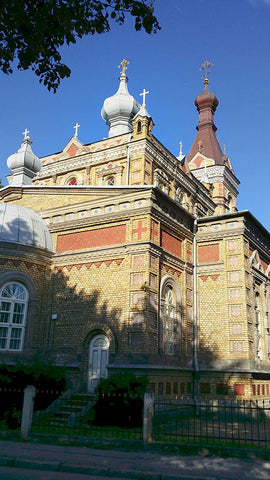
Orthodox church, Pärnu
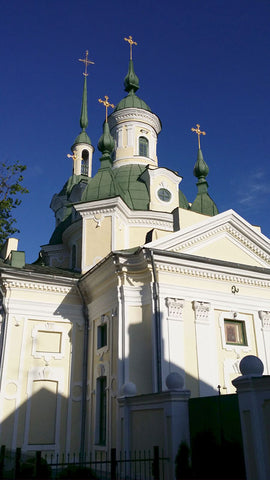
St. Catherine's Orthodox Church, Pärnu

Brick facade, Pärnu
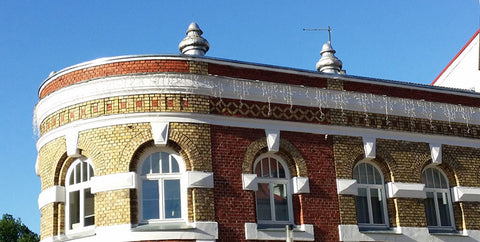
Brick facade and blue sky, Pärnu
Of course, as in almost all the towns and squares in the Baltic countries in which we traveled, there were great public displays of flowers in Parnu.
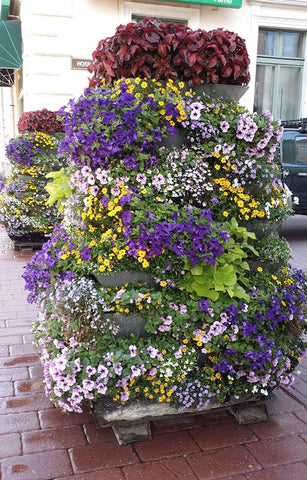
Street flowers, Pärnu old town
After our walk, we had a lovely breakfast in the restaurant associated with our hotel. The hostess had a PERFECT Australian accent which I mistook as an Australian background. No, seems she was there as a student for a few years; she was an Estonian. We bid Pärnu goodbye, headed for the coast road and were FINALLY on our way to Latvia!
The drive from Tallinn to Haapsalu was dominated by the mysterious Estonian countryside. We spent miles and miles driving through endless acres (or to be European, hectares) of very flat hay fields. Some had round or rectilinear hay bales dotted on the mowed fields. The odd thing was that we saw almost no animals. Perhaps, a hundred cows all told. No horses, sheep, or even people. The occasional farm house or barn, but no life -- very Twilight Zone.
All that changed in Haapsalu, an old spa resort town, historically renowned for its restorative mud, rich in trace minerals. This healing mud made Haapsalu a destination for people from countries far and wide wishing to be cured of aches and pains. The town boasts having the Russian Imperial family (including Alexander I, II and III, Peter I and Nikolai II) among its guests. You can still find spas and rehabilitation centers there. This, however, was not our reason for going. I wanted to go to the Haapsalu Lace Center to see the (small) museum, and see if there was a shawl that needed to come home with me.
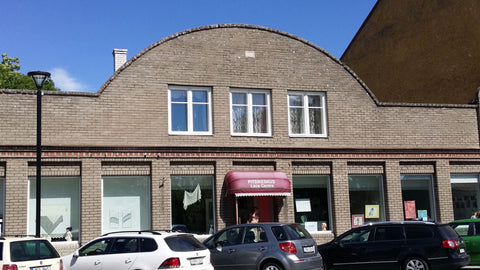

The Haapsalu Lace Center
What a lovely selection of shawls! After somewhat halting conversations with the Estonian women who were manning the shop, I bought a large square shawl with a traditional design, a new book “Estonian Knitting 1. Traditions and Techniques” (http://epood.saara.ee/en/pood/estonian-knitting-1), the first in a series, AND a ball of yarn for a forthcoming shawl knitting project of my own.


Ilga's Haapsalu lace shawl
I chose this shawl because of it's extremely fine and beautiful crafts(wo)manship and the simple central pattern looked very nice when folded over into a triangle (as I am likely to wear it). It was certainly a very difficult choice to make. A bit pricey, so I had to chose just one from the scores of gorgeous shawls!
After our mission was accomplished, we walked around the town and on the sandy land along the inlets dotted with reed islands sporting many birds. It was deceptive, we thought we could walk out onto the shore, but the reedy swamps inhibited our exploration as did the positively gale force winds. It was actually hard to stand up or even hold the camera steady. A few hardy sunbathers were lying on the beach nonetheless.

The shore at Haapsalu
From there, we retreated back to the town to look at some of the wonderful ‘wooden lace’ buildings (what we would call ‘gingerbread’----Isn’t ‘wooden lace’ so much more descriptive?) and the remains of the old bishop’s castle, once the seat of government for this part of Estonia.
Mike walked quickly around the ruins, while Ilga waited in the shade of a tree and people-watched while knitting. The castle is a big place, renovated many times during its history, and is currently being restored. A city park has been established around it, including a children’s playground in part of the old moat.

Bishop's castle

Church and tower at Bishop's castle

Gate at Bishop's castle

View from Bishop's castle

View from Bishop's castle
Then we drove through the even emptier countryside – just hayfields scattered here and there, surrounded by stands of trees. Very flat, with few signs of habitation. We came upon the village of Lihula – a rare hill in the plains. This was the site of an ancient hill fort, which had been replaced by a German crusader castle, then by a Swedish castle, then by a manor house. One had a sense of the many layers of history lying together, making for a very evocative site.
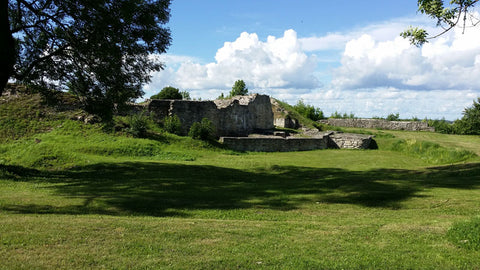
Lihula castle ruins
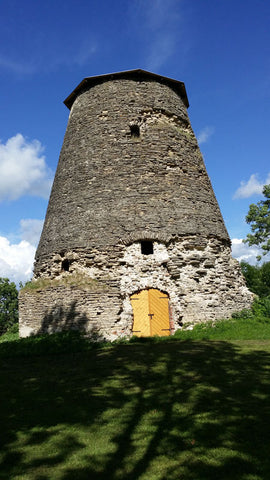
Tower at Lihula castle ruins
In the village itself, we found the striking ruins of an old red brick and stone Orthodox church, now roofless and colonized by trees. It seemed of a piece with the ruins back up on the hill. After a few photos there, we got back on the road, and made it the rest of the way to Pärnu, our stop for the night.
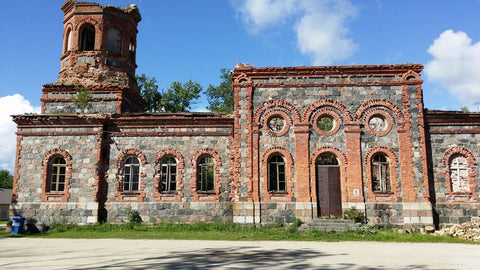
Abandoned Orthodox church
Tallinn’s old town, a UNESCO World Heritage Site, is a remarkably picturesque, medieval town with many 14th to 17th century buildings, beautifully preserved and maintained. I hate to admit that I slept much of the time while we were there. Between the jet lag and the long journey, I was really quite exhausted. Mike recovered more easily and “cased out the town” while I slept -- so I didn’t miss the architectural highlights. He would come back to our pretty hotel and talk of how crowded it was. However, when I would accompany him in the evening, the city was quiet, with a modicum of tourists for such a lovely place. Turns out that during the day the town is infiltrated by hundreds of cruise ship tourists, in gaggles following their banner-carrying guides. At round 5:00pm, they are marched back to their ships for (I imagine) their evening meals. Given the long evenings, that left us hours to wander the cobbled streets in relative calm. Given the dubious weather (it threatened to rain constantly), the skies were quite dramatic, which enhanced the pretty town.

Street scene in Tallinn Old Town

Steeple of St. Nicholas Church, Tallinn Old Town
I was particularly enraptured by the old abbey gateway -- one of the oldest surviving structures in the city.

Detail of arch, St. Catherine's Cloister
Our hotel was on a little plaza that had a gazebo in the middle. A few times a day, various groups of musicians in period costumes would play medieval music. It was a charming touch. We saw a number of street musicians throughout the town, playing everything from medieval recorder and bagpipe music to “Cotton Fields Back Home” (which the band on the ferry from Helsinki had played, too).

Street musicians outside our hotel
Many of the houses in old town Tallinn are traditional tall and narrow merchant houses. The top floor of these houses would have been used for goods storage with stored items moved up and down via a pulley system. Some of these houses still have the pulley rigging in place.

Merchant's house with pulley hoist
Above the old town of Tallinn stands the citadel hill, known as Toompea. This houses the town’s major churches, as well as the Parliament building. Some of the old fortress walls and towers are still standing, including one known as Kiek in de Kök, or “peek in the kitchen”, since those in the tower could spy on the houses below. Some of the lower town walls are accessible, as well, giving view down into the streets of the town. Some of the original town gates still offer passage between the old town and the new.

View of Kiek in de Kök

View from the lower town walls

Viru gate leading from the Old Town to the new.
One evening, we had a spectacular dinner at the Hermitage Restaurant (adjacent to our hotel). Having been very warm all day, we ate outside next to the gazebo. This turned out to be the finest meal of our trip. A highlight was my dessert, called a “deconstructed cheesecake”, served in a small fishbowl and looking like a miniature garden.

Deconstructed cheesecake at the Hermitage Restaurant
After a couple of nights in Tallinn, and jet lag recovery mostly completed, we picked up our rental car and set off for Haapsalu, the first fiber-focused stop of the trip…
We will be posting some blog entries about our 2016 trip to Finland, Estonia and Latvia. This is Part 1, covering the beginning of our trip in Helsinki.
It was a right, fine flight to Reykjavik. Windy and wild on the runway when we landed and it turned out to be a very close connection. They even held the bus to the next plane for us. Icelandair's Saga Class is a winner! The food was great on the flight as were the movies. We watched “Spotlight” as our film and also checked off all the Icelandic films (some of which we had already seen at SIFF). I knit a LOT while flying, usually starting a new knitting project (generally a shawl) on the runway here in Seattle. One of the Icelandic flight attendants was very interested in my knitting (and the carbon fiber needles). She said that she always had socks on her needles when flying, waiting in her purse for when she had a few moments to fill. After making the close connection in Reykjavik, I found the flight to Helsinki to be most frustrating for me. I was very tired, but not able to find a comfortable postion to sleep. Mike nodded off, but I wasn't as lucky and consequently was VERY groggy and grumpy by the time we landed.
We took a train (about half an hour) to the center of town. Our hotel was only a few blocks walk…but it was still a hassle burdened with bags and exhausted. It was rainy most of the time we were there, in fact, Mike took a walk and got DRENCHED. Fortunately, we were able to dry out his clothes and (most importantly) shoes on the heated floor of the bathroom. We had a great night’s sleep….on a memory foam bed with down comforters and down pillows at the Radisson Blu Plaza Hotel. In the morning, at breakfast, there was a shot glass at all of the settings. We wondered about that until a waitress came and filled our glass with our “health shot” for the day. I'm speculating that it was a refined form of cod liver oil (we sometimes take one at home, which has no relation to the stuff my grandmother used to give to me). It was tasty as was the breakfast.
The following day, before our ferry to Estonia, we walked through the Kaisaniemi Botanical Garden, a branch of the University of Helsinki, very close to our hotel. Some familiar plants, some not so much. One of the highlights was several stands of martagon lilies.


Martagon lilies at the Kaisaniemi Botanical Garden
There were birds that looked like magpies with ornate songs in the garden. They entertained us with long, complicated songs….apparently protecting their respective territories. One had the widow’s walk of the central conservatory as his own and he could be heard throughout the upper garden. Obviously a very strategic place. The botanical garden was the first place (many more to come) that I was bitten by a European mosquito on this trip (while sitting on a bench knitting in the pinetum).
An interesting felted beehive hung from a tree. It was shaped like an upside down pomegranate…with the entrances for the bees as little holes around the bottom plate. It was camouflaged with a mass of thin twigs gathered at the top. the description said that it’s purposely made as a hive that can’t be accessed by humans. This, so the bees have all the honey for themselves. I know that bees like straw because it is just the right temperature and insulates them well in the summer and the winter (hence the ancient art of straw skeps as bee homes). I would imagine the felt does the same. I think I shall make one or two for the “back 40” or for Coyote Ridge here at Edgewood Garden.

Felted beehive "Bee Ark" in the botanical garden. Photo from http://melliferopolis.net/
The shopping areas of Helsinki were decked out in many imaginative potted flower arrays, something we subsequently found in many towns and cities in Estonia and Latvia.
 .
.
Street flowers near the Helsinki central train station
We wandered through the shopping district and came upon an art installation in a small park, some enchanting polka dot tree clothes, an art installation by the Japanese artist Yayoi Kusama. There were about a dozen clothed trees around the park plaza.


Dressed trees in a Helsinki park
It was threatening to rain, so we headed back to our hotel to pack up. After a terribly expensive taxi ride to the ferry, we walked the length of an airport to get to our ferry. It was a MASSIVE ship -- some of the ferries that run between Helsinki and Tallinn can carry over 3000 passengers! We’re used to our small Puget Sound ferries, so this was quite unexpected. The level on which we settled had a bar, a tech/office area, and even private rooms with bunks. We sat in the bar area and listened to a live band doing 1970’s country songs. The ferry was the place where I heard my first native Latvian speakers -- a small pack of nine to twelve year old boys were playing hide 'n’ seek, tag and laughing on the stairs. They were all wearing the same colors, so we speculated that they were on a school outing or had gone to some athletic competition. But, I was too shy about my Latvian to ask them, so never did find out.






































































 .
.
